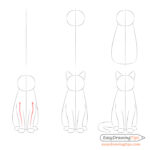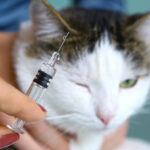Bringing your feline friend on a plane requires careful planning to ensure a safe and comfortable journey. At solcat.net, we understand the complexities involved in pet travel and offer expert guidance to make flying with your cat a breeze. This article will cover everything from airline policies to essential travel tips, ensuring your kitty’s trip is as smooth as possible.
1. Booking Your Cat on a Flight
Can my cat travel with me in the cabin, or will they need to travel in the cargo hold?
Decide whether your cat can travel in the cabin inside a pet carrier or whether they need to fly in the cargo hold. While many animals travel in cargo every day without issue, it is strongly advised to keep your cat in the cabin with you in their pet carrier unless absolutely necessary. This ensures they are safer and more comfortable, avoiding extreme temperatures and potential stress. Additionally, flying with your cat in the cabin is typically less expensive.
There are generally two ways to fly with your cat in the cabin: as a carry-on pet and as an emotional support animal. Regardless, airlines limit the number of animals allowed on each flight, so it is recommended to call the airline before booking to ensure they can accommodate your cat.
Your cat will not receive its own boarding pass, but its presence will be noted on your boarding pass. Sneaking your cat onto a flight is not an option.
2. Carry-On Pets: Policies and Fees
What are the carry-on pet policies for cats on airlines?
Most airlines allow cats to board as carry-on pets in their pet carriers for an additional fee. Costs and policies vary, but expect to pay approximately $100-200 USD per flight. This fee can vary depending on the airline and destination.
Your pet carrier counts as one of your carry-ons, so plan accordingly. Most U.S. airlines allow one carry-on bag and one personal item. Your cat’s pet carrier, placed at your feet, typically counts as your “personal item.” Confirm this with the airline if unsure.
Carry-on pets must remain in their pet carriers on the floor at the foot of your seat for the entire flight. Never place a pet in the overhead compartment.
Line your pet carrier with an absorbent material, such as a blanket or towel, in case your cat gets nervous.
 Cat peeking out of a Travel Cat carrier, implying comfort and security
Cat peeking out of a Travel Cat carrier, implying comfort and security
3. Emotional Support Animals (ESA): Rights and Requirements
What are the requirements for flying with my cat as an emotional support animal?
Emotional support animals (ESAs) provide valuable support to individuals with mental or emotional disabilities. Unlike service animals, which assist individuals with physical disabilities, cats often serve as ESAs.
It is important not to falsely claim a mental or emotional disability. However, if you have a legitimate need for an ESA, do not hesitate to fly with your support animal.
Contrary to some beliefs, there is no “certification” for ESAs. Any certificates or letters for sale online should be considered scams, as confirmed by the U.S. Department of Justice.
To fly with your cat as an ESA, you must submit specific paperwork provided by the airline. This often includes forms completed and signed by a licensed mental health professional, a licensed veterinarian, and yourself. All forms must be submitted for approval at least 48 hours before your flight, and physical copies should be brought to the airport.
ESAs do not require a pet fee and are typically allowed to sit on your lap during the flight in addition to being in their pet carrier.
4. Transporting Your Cat: Choosing the Right Carrier
What type of cat carrier is best for air travel?
For safe and comfortable air travel, choose a carrier designed specifically for this purpose. Solcat.net recommends carriers that allow your cat to sit up or stretch out comfortably under the seat, making the flight easier for both of you.
5. Airline Policies: Size and Breed Restrictions
What airline policies should I be aware of when flying with my cat?
Airlines have different policies regarding pet carriers’ size and breed restrictions. Always double-check with your airline to understand their specific requirements.
- Delta: Soft-sided kennels with maximum dimensions of 18” x 11” x 11” are recommended. Fees range from $75-$200 per pet. (Delta Pet Travel)
- American Airlines: Soft-sided kennels within 18 x 11 x 11 inches are recommended. The fee is $125 per pet. (American Airlines Pets)
- Southwest Airlines: Carriers must be within 18.5” long x 8.5” high x 13.5” wide. The fee is $95 per pet each way. (Southwest Airlines Pets)
- United: Soft-sided pet carriers should be within 18 x 11 x 11 inches. The fee is $125 per pet each way. (United Traveling with Pets)
- Jet Blue: Carriers must not exceed 17″ x 12.5″ x 8.5″. The fee is $125 each way, and only one pet is allowed per person. (JetBlue Traveling with Pets)
- Allegiant Air: Carriers must not exceed 9” x 16” x 19”. The fee is $50 per flight segment, and only two pets are allowed per person. (Allegiant Air Traveling with Pets)
If you frequently fly with JetBlue, Allegiant, or similar airlines with stricter size policies, consider a smaller backpack.
6. Key Airline Requirements: Age, Breed, and Carrier Size
What are the essential airline requirements to keep in mind?
- Age: Most airlines require pets to be a certain age to travel. For instance, Delta requires pets to be at least 10 weeks old for domestic travel, 15 weeks for travel to the EU, and 16 weeks old for international travel. Always verify the specific age requirements of your chosen airline.
- Breed: Some airlines restrict certain breeds, such as brachycephalic (short-nosed) cats like Burmese, Persians, Himalayans, and Exotic Shorthairs, due to potential breathing difficulties at high altitudes.
- Size of Carrier: Choose a pet carrier that fits comfortably under the seat in front of you. Always check the airline’s specific size requirements.
7. Recommended Cat Carriers for Flying
Which cat carriers does solcat.net recommend for flying?
- “The Odyssey” Soft Cat Carrier: Designed specifically for flying, this carrier includes a slide-out mat, roll-down window shade, and convenient side pockets. Its lightweight design and suitcase handle sleeve make it perfect for airport travel.
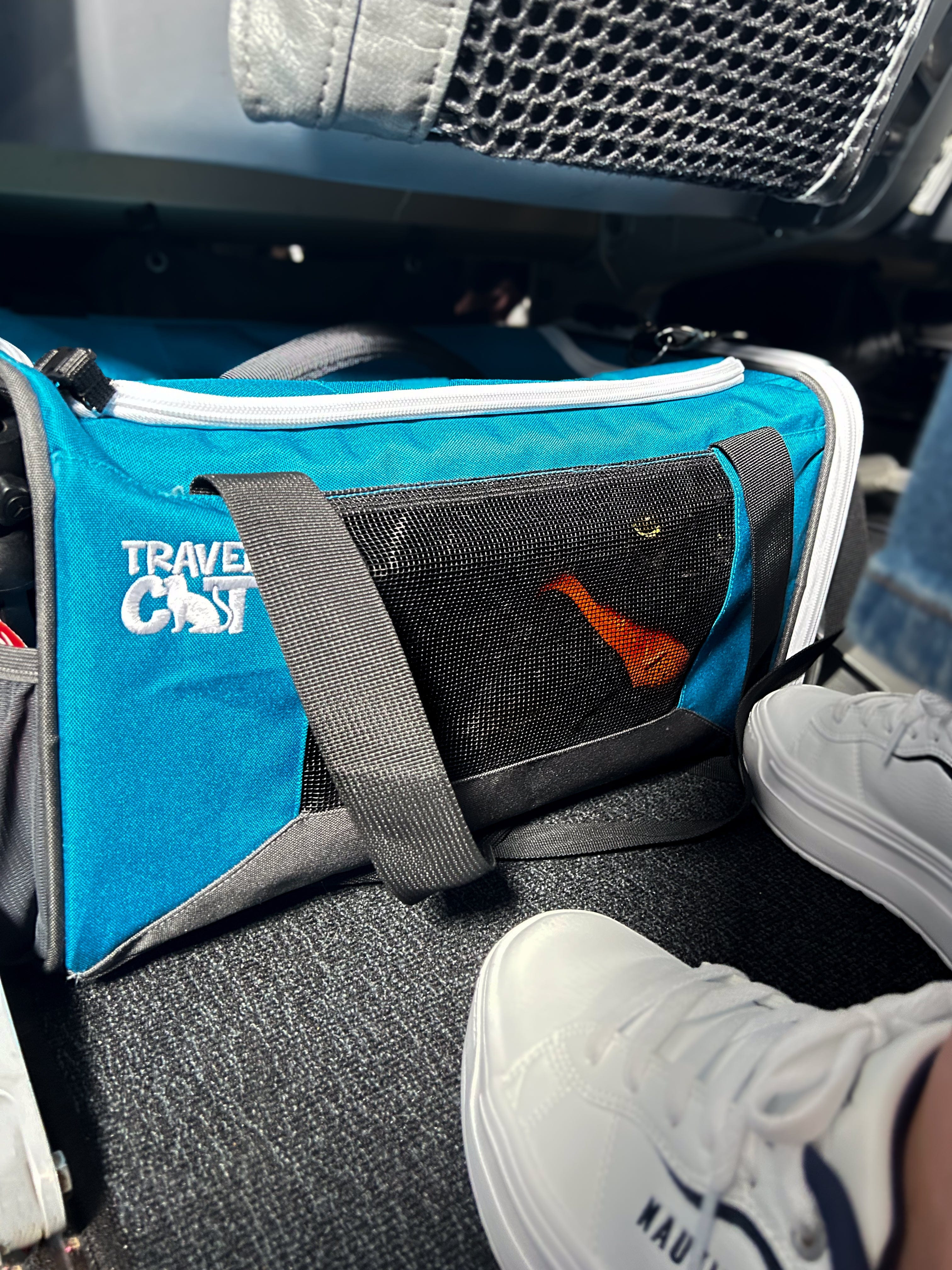 The Odyssey cat carrier, featuring a comfortable design for cats
The Odyssey cat carrier, featuring a comfortable design for cats
- “The Jackson Galaxy” Convertible Cat Carrier: This carrier doubles as a backpack and traditional carrier. The adjustable floor mat allows your cat to stretch out comfortably, and the mesh paneling allows you to check on your cat without disturbing them.
- “The Navigator” Convertible Cat Backpack: This backpack also converts into a traditional carrier and features multiple pockets for storing essentials.
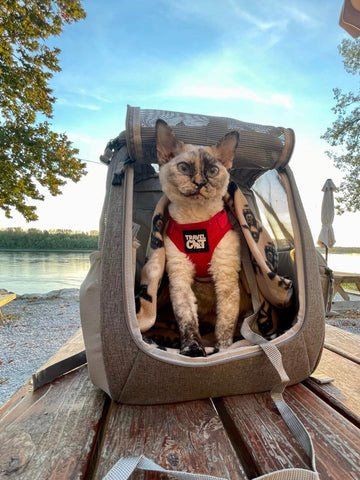 The Navigator cat backpack, ideal for hands-free airport navigation
The Navigator cat backpack, ideal for hands-free airport navigation
- “The Fat Cat” Cat Backpack: Suitable for airlines with flexible size requirements, this backpack provides ample room for your cat to move around and features mesh paneling for airflow and visibility.
8. Leashes & Harnesses
Which leashes and harnesses are recommended for flying with a cat?
“The Wind in My Whiskers” Bundle, which includes “The True Adventurer” Harness & Leash and “The Captain” Retractable Leash, is a travel necessity. These ensure your cat remains safely inside their pet carrier with leash clips.
9. Essential Cleaning Products
What cleaning products should I bring when flying with my cat?
- Pet Hair Remover: Essential for keeping your clothes and surroundings clean.
- Disinfectant Spray: Use a cat-safe disinfectant spray to clean up any accidents.
- Stain Remover: Helpful for dealing with any unexpected messes.
- Wet Wipes: Useful for quick cleanups and keeping your cat comfortable.
10. Feeding Accessories for Travel
What feeding accessories are best for flying with my cat?
- “The Go Anywhere Bowl”: This compact, collapsible bowl is perfect for feeding your cat on the go and easily clips onto your cat backpack.
- “The Travel Buddy” Foldable All-In-One Double Bowl & Mat: This portable food and water dish is easy to clean and fits conveniently in your carry-on.
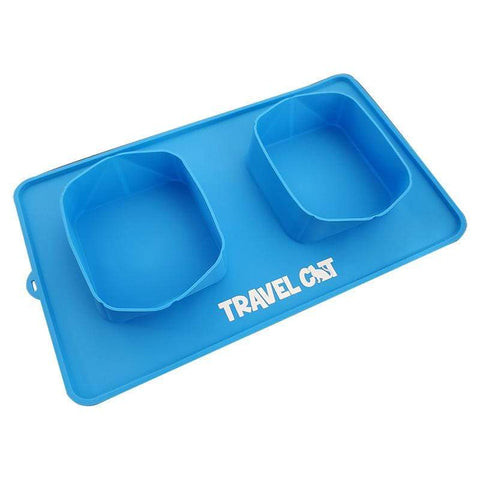 The Travel Buddy foldable bowl, a convenient way to feed your cat during travel
The Travel Buddy foldable bowl, a convenient way to feed your cat during travel
11. Calming Products
Which calming products can help my cat during air travel?
- Familiar Items: Bring your cat’s favorite toys and treats to help them feel more at home.
- Scent-Soaker: A blanket or mat with your cat’s scent can provide comfort.
- “Easy Traveler” All Natural Holistic Solution by Jackson Galaxy: This solution can ease fear, anxiety, and motion sickness.
12. Preparing Your Cat for Travel: Acclimation and Health
How can I prepare my cat for air travel?
- Get Your Cat Used to the Carrier: Ensure your cat is comfortable in their pet carrier.
- Vaccinations and Health Certificate: Your cat needs to be up to date on their vaccinations, with an active rabies vaccination certificate required. Many airlines also require a health certificate.
- Calming Aids: Consult your vet about calming aids if your cat is prone to anxiety. CBD can also work wonders.
13. Items to Pack
What items should I pack for my cat’s trip?
Pack essential items, including food, a portable litter box, a travel bed, and toys. Pack these items with your belongings to ensure everything fits appropriately.
On the day of travel, avoid feeding your cat breakfast to prevent accidents. Purchase a disposable pee pad to place at the foot of the carrier.
14. Navigating the Airport: Check-In and Security
How do I navigate the airport with my cat?
Upon arrival, check in at the airline’s desk, as online check-in is not allowed when traveling with an animal. The desk attendant will need to see your cat (in the carrier) and any required paperwork, such as a health certificate.
Like all passengers, your cat will need to go through airport security. If using regular TSA security, you will need to remove your cat from the carrier. The carrier will go through the x-ray machine, and you will walk through the metal detector with your cat in your arms.
Use a cat harness and leash to prevent your cat from running off. If your cat is skittish, request a private screening room.
15. Boarding the Plane: Priority Boarding and Comfort
How do I board the plane with my cat?
Check with the gate agent for priority boarding, as passengers with animals are often allowed to board early. This helps you get your cat situated before the plane fills up.
Once seated, drape a familiar blanket or jacket over the carrier to block out noise and movement. Buckle up and ensure a safe flight.
16. Addressing Common Concerns: Bathroom Breaks
How will my cat use the bathroom on the plane?
Nervous cats may need to use the bathroom more often. “The Porta Pawty” Portable Litter Box is a convenient way to provide a place for your cat to go.
17. Addressing Common Concerns: Sedation
Should I sedate my cat for the flight?
Sedation is generally not recommended. Some airlines do not accept sedated animals. Unless your cat is prone to extreme panic attacks, find other ways to comfort them or leave them with a trusted friend or family member.
According to the American Animal Hospital Association (AAHA), sedating pets before flying can be risky, as it may affect their breathing and heart rate at high altitudes. Consulting with your veterinarian is crucial to determine the best course of action for your pet’s specific needs.
18. Addressing Common Concerns: Feeding Schedule
When should I stop feeding my cat before flying?
While water should always be available, stop feeding your cat 4-6 hours before takeoff. If your cat is prone to motion sickness, ask your vet for medication.
19. Traveling Internationally with a Cat
What are the specific requirements for international cat travel?
Traveling internationally with a cat involves additional regulations and health requirements. Ensure your cat has a microchip, a valid rabies vaccination, and a health certificate issued by an accredited veterinarian. Contact the embassy or consulate of your destination country to understand their specific pet import requirements.
The Centers for Disease Control and Prevention (CDC) also provides guidelines for importing animals into the United States. Compliance with these regulations is essential to avoid quarantine or denial of entry.
20. Choosing Pet-Friendly Accommodations
How do I find pet-friendly accommodations at my destination?
When planning your trip, research pet-friendly hotels, rental properties, or other accommodations. Websites like BringFido and Petswelcome offer comprehensive listings of pet-friendly places to stay. Ensure the accommodations meet your cat’s needs, with adequate space and amenities.
21. What to do if your cat shows signs of distress during the flight
How can I help my cat if they show signs of distress during the flight?
If your cat exhibits signs of distress, such as excessive meowing, panting, or agitation, try to reassure them with a calm voice and gentle stroking (if possible without opening the carrier). A familiar toy or blanket can also provide comfort. If the distress persists, consult with a flight attendant for assistance.
22. Post-Flight Care
What should I do when I arrive at my destination to ensure my cat’s well-being?
After arriving at your destination, allow your cat time to adjust to their new surroundings. Provide a quiet space with their familiar belongings. Offer food and water, and monitor their behavior for any signs of stress or illness. If you have concerns, consult with a local veterinarian.
23. Legal Considerations
Are there any legal considerations for flying with a cat?
Several laws protect the rights of passengers with disabilities who require the assistance of service or emotional support animals. The Air Carrier Access Act (ACAA) prohibits discrimination based on disability in air travel. Familiarize yourself with these regulations to ensure your rights are protected.
24. The Impact of Altitude on Cats
How does altitude affect cats during air travel?
High altitudes can impact cats’ respiratory systems, particularly those with pre-existing conditions. Short-nosed breeds like Persians and Himalayans may be more susceptible to breathing difficulties. Consult with your veterinarian to assess your cat’s fitness for air travel and discuss potential risks.
25. Alternatives to Flying
What are the alternatives to flying with a cat?
If flying with your cat seems too stressful or impractical, consider alternative options, such as hiring a professional pet transportation service or boarding your cat at a reputable facility. These options may provide a safer and more comfortable experience for your feline companion.
26. Budgeting for Pet Travel
How can I budget for flying with a cat?
Flying with a cat involves various expenses, including airline fees, carrier costs, health certificates, and pet supplies. Create a budget to track these expenses and plan accordingly. Compare airline pet fees and look for discounts on pet travel products.
27. Understanding the Airline’s Liability
What is the airline’s liability if something happens to my cat during the flight?
Airlines typically have limited liability for pets traveling in the cargo hold. Review the airline’s pet travel policies to understand their responsibilities and coverage in case of injury, illness, or loss. Consider purchasing pet travel insurance to protect against potential financial losses.
28. Cat Breed Considerations
What breeds are more suited for air travel?
Certain cat breeds are better suited for air travel due to their temperament, health, and adaptability. Breeds like the American Shorthair, Maine Coon, and Siamese are generally more relaxed and resilient. However, individual cats vary, so consider your cat’s personality and consult with your veterinarian.
29. What should I do if my cat gets lost at the airport?
How can I prevent my cat from getting lost at the airport?
To avoid your cat getting lost at the airport:
- Keep your cat securely in their carrier or harness.
- Attach identification tags with your contact information to the carrier and harness.
- Take a recent photo of your cat in case they get lost.
- Notify airport security and airline staff immediately if your cat goes missing.
- Use social media to spread the word and ask for assistance.
30. What is the best way to acclimate my cat to a new environment after flying?
How can I help my cat adjust to a new environment after flying?
- Provide a safe and quiet space with familiar items.
- Offer food and water and encourage them to use their litter box.
- Spend time with your cat, offering reassurance and gentle petting.
- Gradually introduce them to new areas of the environment.
- Monitor their behavior for signs of stress or illness.
Flying with your cat requires careful planning and preparation to ensure a safe and comfortable journey. By understanding airline policies, selecting the right carrier, and taking steps to reduce your cat’s stress, you can make the experience more enjoyable for both of you. Visit solcat.net for more tips and resources on pet travel.
At solcat.net, we are dedicated to providing the most reliable and up-to-date information to help you care for your feline companion. Our expert advice ensures that you are well-prepared for any travel situation.
Ready to make your cat’s next flight a success? Explore our resources and connect with our community of cat lovers at solcat.net! Visit us at 950 Alaskan Way, Seattle, WA 98104, United States, or call +1 (206) 386-4000. Your purrfect travel experience starts here!
FAQ’s
How will my cat use the bathroom on a plane?
The most convenient way to provide a place for your cat to go while traveling is with “The Porta Pawty” Portable Litter Box. Its seamless interior liner is a breeze to clean between uses, and the zippered top prevents spills. It is lightweight, collapsible, and comes with handles for easy carrying.
Should I sedate my cat?
Definitely not. Some airlines won’t accept sedated animals, plus it is just plain unnecessary. Unless your cat is extremely prone to panic attacks during travel, we advise you to find other ways to comfort them, or leave them with a trusting friend/family member while you’re away.
When should I stop feeding my cat before flying?
While water should always be accessible to your kitty, stop giving them food 4-6 hours before take off. Pre-flight nerves & nausea get the best of us, and they will be fine to wait a little bit until you’re safely sky high. If your cat is extra prone to motion sickness, ask your vet for medication to make their trip a little more pleasant.
What if my cat is not allowed to fly in the cabin?
If your cat is not allowed to fly in the cabin due to airline restrictions or other reasons, you may need to consider alternative transportation options, such as ground transport services specializing in pet relocation. Ensure that the transport service is reputable and provides a safe and comfortable environment for your cat.
How can I make the pet carrier more comfortable for my cat?
To make the pet carrier more comfortable for your cat, line it with a soft blanket or towel that has your cat’s scent on it. Include a favorite toy or treat to provide additional comfort and reassurance. Ensure the carrier has adequate ventilation and is appropriately sized for your cat to stand, turn around, and lie down comfortably.
What documents do I need to fly with my cat?
When flying with your cat, you typically need a health certificate issued by a licensed veterinarian, proof of rabies vaccination, and any additional forms required by the airline. International travel may require additional documentation, such as an import permit or endorsement from the destination country’s embassy or consulate.
Can I bring my cat on any flight?
No, not all flights allow pets. Some airlines have restrictions on the number of pets allowed per flight or may not permit pets on certain routes or aircraft. Always check with the airline before booking your flight to ensure that your cat can travel with you.
What happens if my cat has an accident in the carrier during the flight?
If your cat has an accident in the carrier during the flight, clean it up as soon as possible using pet-safe wipes and disinfectant spray. Line the carrier with absorbent material, such as pee pads or towels, to help contain the mess and keep your cat comfortable. Bring extra supplies to replace soiled bedding if necessary.
Is it better to fly with a kitten or an adult cat?
Both kittens and adult cats can travel by plane, but kittens may require more frequent feeding and bathroom breaks. Adult cats may be more adaptable to travel, but their temperament and health should be considered. Consult with your veterinarian to determine whether your cat is fit to fly, regardless of age.
How can I prevent my cat from escaping its carrier at the airport?
To prevent your cat from escaping its carrier at the airport, ensure that the carrier is securely latched and that the door cannot be easily opened from the inside. Use a leash and harness to keep your cat safely contained when removing them from the carrier for security screenings or other purposes. Always keep a close eye on your cat and supervise them closely to prevent them from slipping away.

